Garibaldi class armoured cruisers (1901)

 Italy/Argentina (1894-1904)
Italy/Argentina (1894-1904)
Four Armoured Cruisers: Garibaldi, Belgrano, Puyrredon, San Martin
The six Argentinian Armored Cruisers
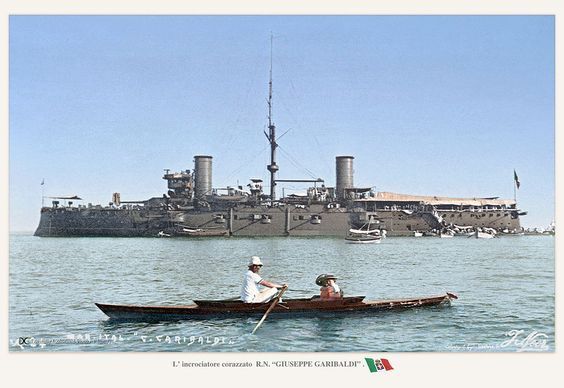
The Garibaldi class is an Italian class or armoured cruisers planned in 1893, well balanced and which met such success it was the most exported type of its era. More than 10 ships, with the 11th planned cancelled. The first four were sold to Argentina (the others being Spain and Japan and of course Italy). Whats maked it confusing is the name retained for both the Argentinian and Italian class, related to an historical figure revered both in Italy for the unification and in Argentina for the independence. Designed chief engineer Edoardo Masdea these cruisers were compact for a more logicial arrangement of the armour, combined with powerful armament, and still a satisfactory speed for fleet actions. Argentina was also the largest user of the class, with four ships, relaunching the naval arms race with Brazil and chile at the time.
The Garibaldi class were versatile ships designed to perform originally both their traditional cruiser role, and to act in a battleline if neede thanks to their protection and heavy armament. They were seen as a good intermediaries between both cruisers and battleships. Also given the standard of the time, they were built relatively quickly at a lower cost than most shipyards, which combined to make these the export success of the decade. Until then, Britain, France and Germany were the great providers, and the Garibaldi class showcased the arrival of the Italian shipbuilding industry on the international scene.
This single cruiser outperformed Armstrong designs, which made the staple of south armerican three great naval powers at the time, Brazil, Argentina and Chile. With four ships of that quality they resonated lik a thunderstruck on the latin continent, and relaunched the race. Famously this conducted Brazil to Approach Britain when the construction of the Dreadnought was known, and with the order of such as class in answer to the Argentina (The Minas Gerais class), it launched a second arms race, this time with dreadnoughts (the first one was with cruisers)…
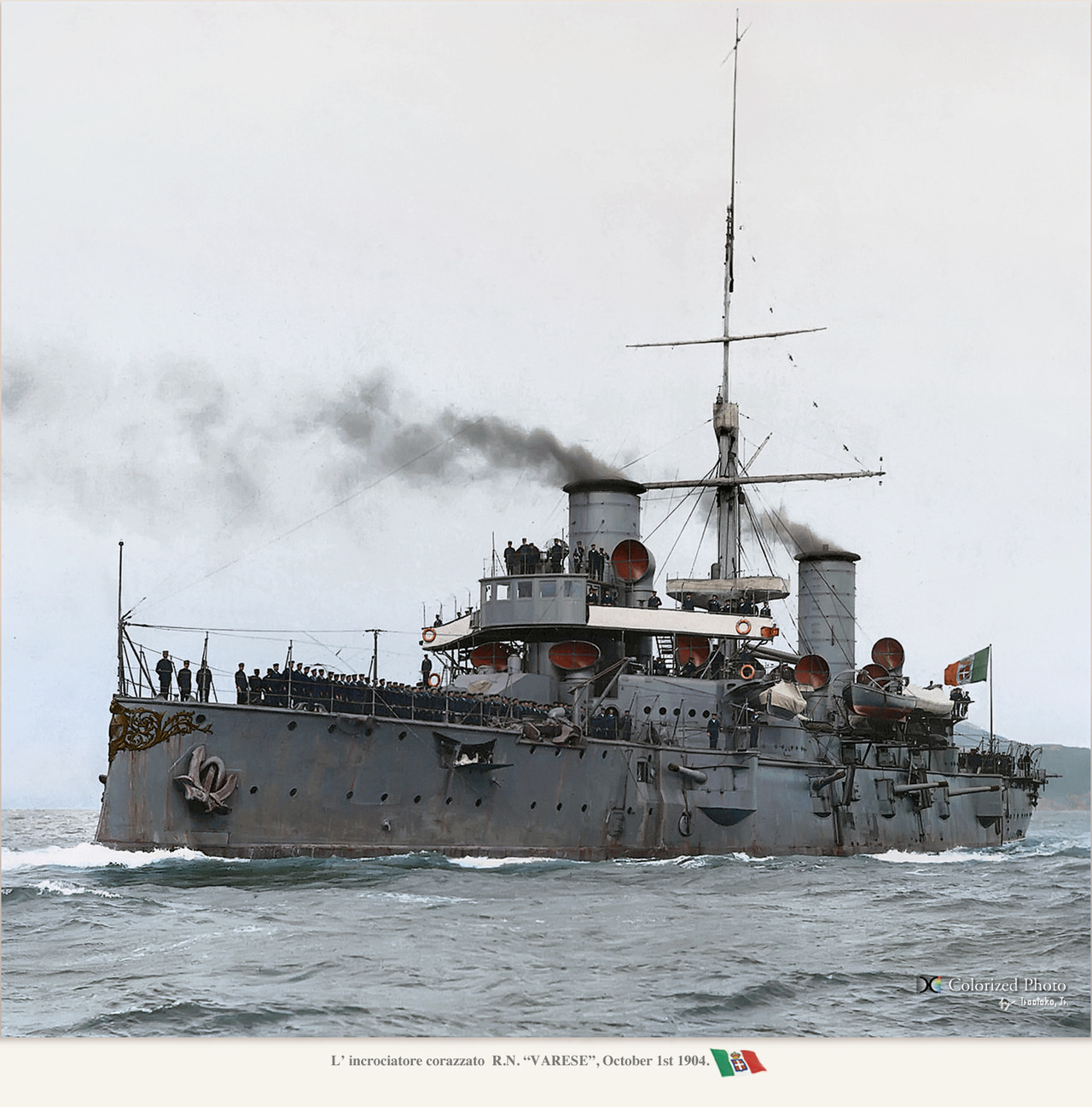
Varese, colorized by Irotoko Jr. (as all the color photos following).
Design Genesis
The design of the Giuseppe Garibaldi-class was submitted to naval architect Edoardo Masdea in 1893, known for his successful Vettor Pisani-class. Submitted to the admiralty in his quality of chief naval engineer, he refined a project of Marina Minister Benedetto Brin, and this was intersected with further suggestions by Ansaldo Yard before construction. This team work turned to be perhaps the most successful in the Italian shipbuilding history. Ansalso Yard indeed were ordered the first ship, as a prototype. Brin suggested to rework the design indeed of the Vettor Pisani and blend its design with the novelteies brought by the St Bon class Battleships. The latter were indeed faster than the Pisani and thus speed became a priority (at least superior to the latest Italian Battleships…).
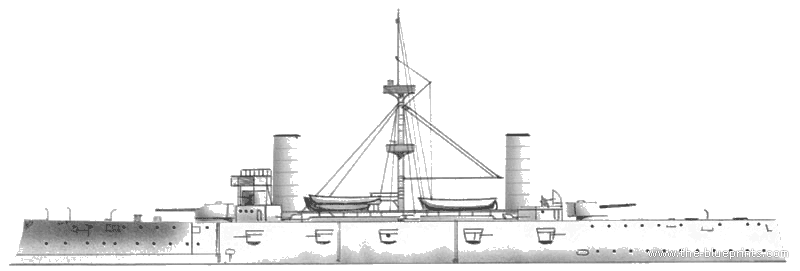
The Admiralty wanted Armoured Cruisers in conformity with the usual rules of the type, bith able to work as commerce raiders and escorts, but also to act closely with the fleet, in a battleline so fighting cruisers and destroy convoys, protect their own and combat in a regular battle. They needed to have better protection and armament standards, combined with the speed of a cruiser. The latter was to ensure their survival for any chance encounter against a battleships.
Brin worked with Masdea, starting with the Vettor Pisani design, but increases in displacement added 1,000 tons to reach requirements, a larger internal hull space meaning a greater powerplant. The final product was nothing short of an accomplishment, combining better armament as before, with heavy guns that can even seriously damage any battleship, adequate protection, and 20 knots top speed. This quadrature of the circle, a daunting task for engineers, appared to have been perfectly balanced and 40% of the total displacement went to to structural weight, 15% to artillery, 25% to the armor, 20% to the powerplant, reflecting these choices.
In the end however the cruisers turned to be only a knot faster than the Pisani class, and were initially designed with two twin gun turrets (8-in) instead of larger single guns, but the option was left open as the Argentinian naval attaché in Italy, keeping a watchful eye on the admiralty’s public requirements, and Ansaldo’s own records, certainly knew about the design.
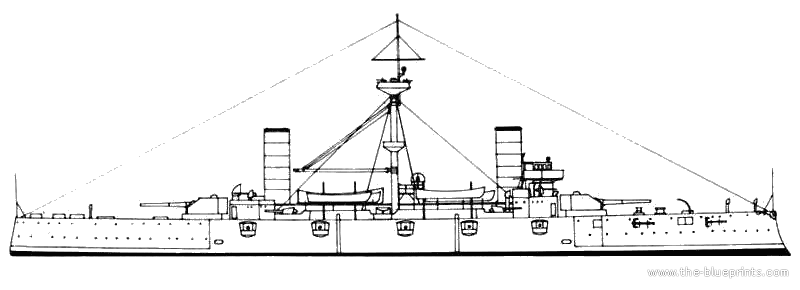
Garibaldi with her final two twin 10-in configuration
Argentinian Order
Indeed at the time, let’s recall what was the mood on the other side of the Atlantic. In South America, there has been an ongoing naval race between the three naval giants of the time, Brazil, Argentina and Chile. To be more precise, the new cruisers would be ordered at the end of the first naval arms race between Argentina and Chile alone. Brazil was not deirectly included into it, but looked for not having its standing degraded and be outclassed, especially in the end.
Intermediaries made known to the Argentinian government the qualities of the Italian design. It was not easy to ask the Italian Navy to sell outright its brand new and awaited armoured cruisers as itself had a lot of local competition to undertake. The sale came about after pressure from the Genoese financier Ferdinando Maria Perrone, at the time Ansaldo’s representative in Buenos Aires, which caused an uproar when known in Chile.
The ARA Garibaldi, freshly completed, left Genoa on October 13, 1896. One more ex-Italian ships will follow, and then four more of the same ordered as Chile prepared its answer.
Here how it went:
⚙ The naval Arms Race | |
 Armada de Argentina Armada de Argentina |  Armada de Chile Armada de Chile |
| Libertad class (BB) 1887 Veinticinco de Mayo (PC) 1890 Nueve de Julio (PC) 1891 Buenos Aires (PC) 1894 Garibaldi (AC) 1895 San Martín (AC) 1896 Pueyrredón (AC) 1897 General Belgrano (AC) 1898 Rivadavia, Moreno* (AC) 1901 |
Capitán Prat (BB*) 1887 Presidente Errázuriz (PC) 1887 Presidente Pinto (PC) 1887 Blanco Encalada (PC) 1892 Esmeralda (AC) 1894 Ministro Zenteno (PC) 1894 O'Higgins (AC) 1896 Constitución class (BB) 1901 Chacabuco (PC) 1901 |
A table is worth a thousand words. This shows the way the garibali class were ordered after a long naval race started in 1887, so over ten years. Argentina answered Esmeralada, essentially the largest protected cruiser (and world’s largest cruiser) at the time in 1892, with ARA Buenos Aires (1895), built in Britain a 4,788 long tons (4,865 t) ship capable of 23.2 kn (26.7 mph; 43.0 km/h) but with moderate protection and armed with “just” two 8 in and four 6 in guns, whereas the new Italian project promised to be less fast but far better protected with twice the armament.
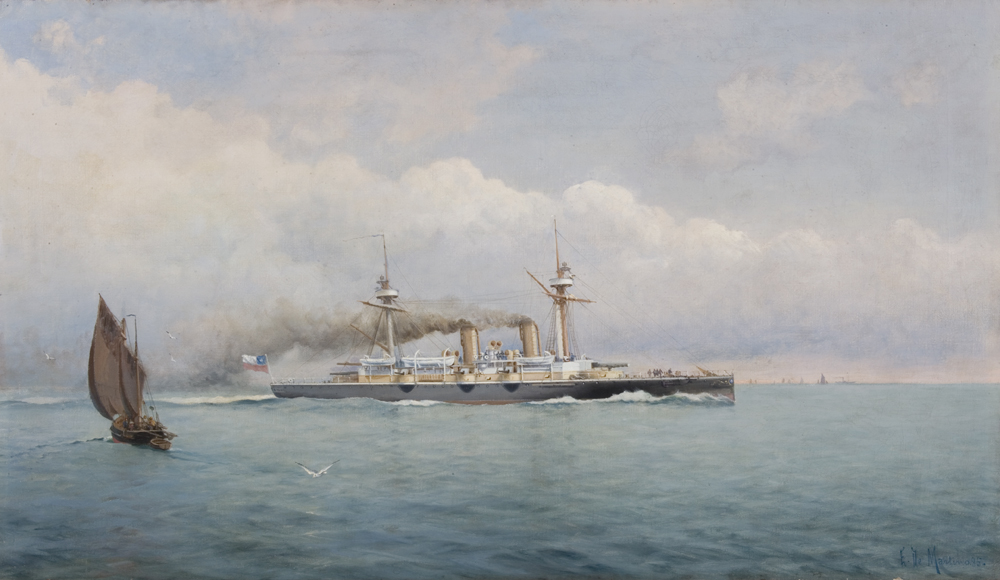
The Chilean Cruiser Esmeralda, world’s largest at the time.
Moroever, contacts made in Ansalso Yard, already ordered to built the prototype, were really promising as if Argentina was willing to pass an order for two cruisers, answering the new Chilean cruisers on order in 1895 (Esmeralda and Zenteno), the overall cost (based on three firm Italian orders, plus similar prospects for Spain were well engaged) was to be cheaper than a repeat of the Buenos Aires, or any armoured cruiser proposed by Britain.
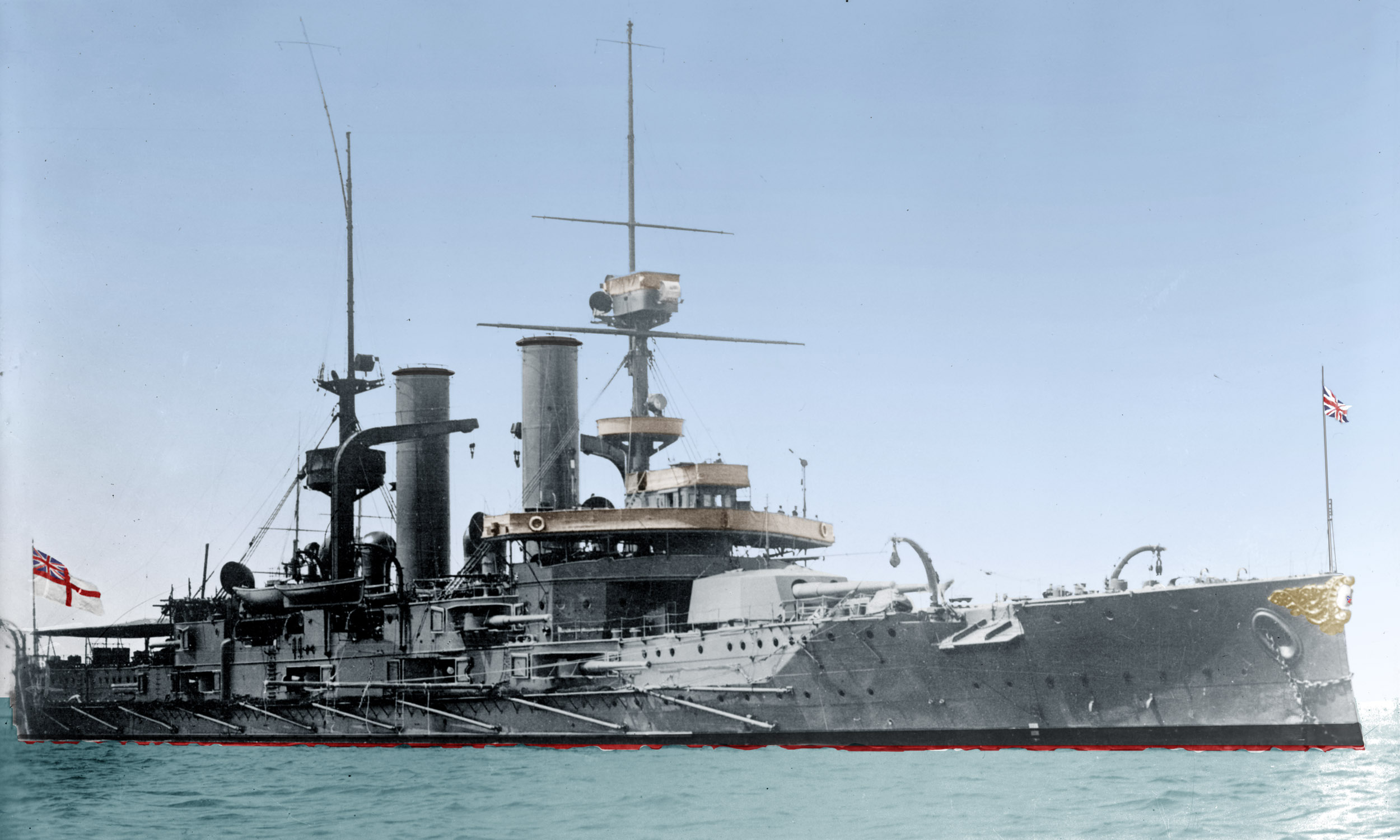
The Constitución class were designed by Chile as “Garibaldi-Killers”. The Pacts of May ended the naval race and both were repurchased by the Royal Navy as the Swiftsure class.
Later to the italian order, the Chileans answered with their first own armoured cruiser, O’Higgins, a 8,500 long tons ship fully loaded capable of 21.6 kn and armed with four 8 in (203 mm)/40 and ten 6 in (152 mm)/40 guns, so up to par. To this, the Argentinians ordered in answer two more of the Garibaldi class (Veinticinco de Mayo and Pueyrredón).
However, the Chileans were not long to answer in form, and ordered in britain this time a “Garibaldi-killer”, the Swiftsure class. They were more pre-dreadnought than armoured cruisers, in fact an in-between, fast and very well armed to surclass the Argentinians.
As soun as they were announced, the Argentinian government answered with the Rivadvia class, also armoured cruisers, but proposed at the time to all yards. If the race was no stopped, they could well have been duplicates of the new Italian pre-project for the Pisa class (1907), or an US equivalent.
However as things went, the race was halted at this point, and relaunched as Brazil in 1906 was looking after Britain’s new dreadnought type then firmly wiling to catchup. It was follow closely by Chile, but the latter failed to enter the new race due to grave economic issues, but Argentina relaunched the Rivadvia class this time as dreadnoughts in 1907.
Britain whistled the end of the match
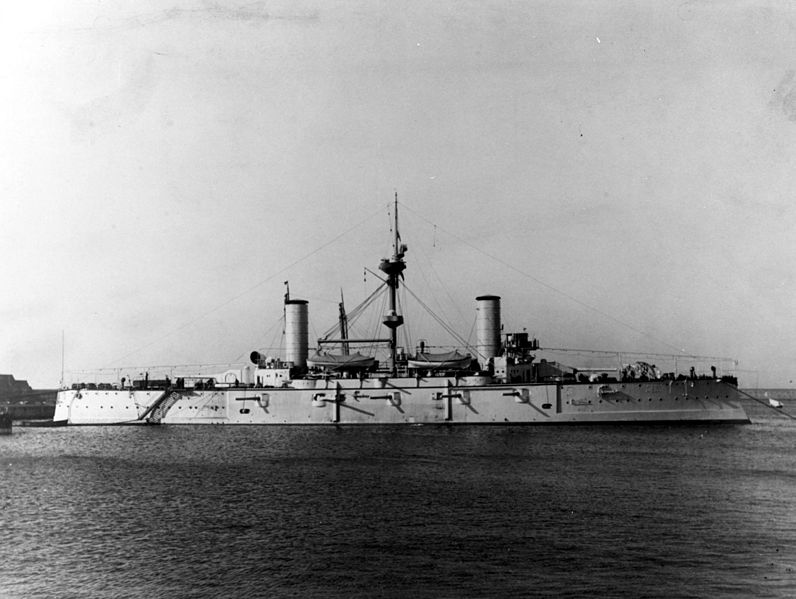
The race was ended by Britain itself, which was worrying about the strain these orders, (which she benefited until the Italian order) took on national economies of both counties, on which Britain tightly depended for its own supplies. The Argentine government purchase £4,534,800 worth of ships between 1890 and 1898, but only thanks to large foreign loans, given to them despite its role in the Baring crisis of 1890. Argentina’s total foreign debt reached 421 million gold pesos by 1896 and Chile was even in a worse situation, forced to take out a £2 million pound loan to puchase purchase Krupp armament, on top oof many other loans, which litteraly starved the local industry of funds, and led the international and powerful British “City” banking sector to suspend loans to Chile, until the diplomatic crisis with Argentina was solved. Eventually President Julio Argentino Roca and American ambassador William Paine Lord pressured both governments to end the race based on the threat of loans suspension.
The “Pacts of May” succeeded into lessening tensions and quasi war state, and let both economies rest a bit, that is until Brazil entered the fray in 1904 when its congress passed a large naval construction plan followed by the dreadnought order in 1907. Following this, both Argentine and Chilean governments cancelled the remaining ban months of the Pacts of May.
The last two cruiser, “Roca” and “Mitra”
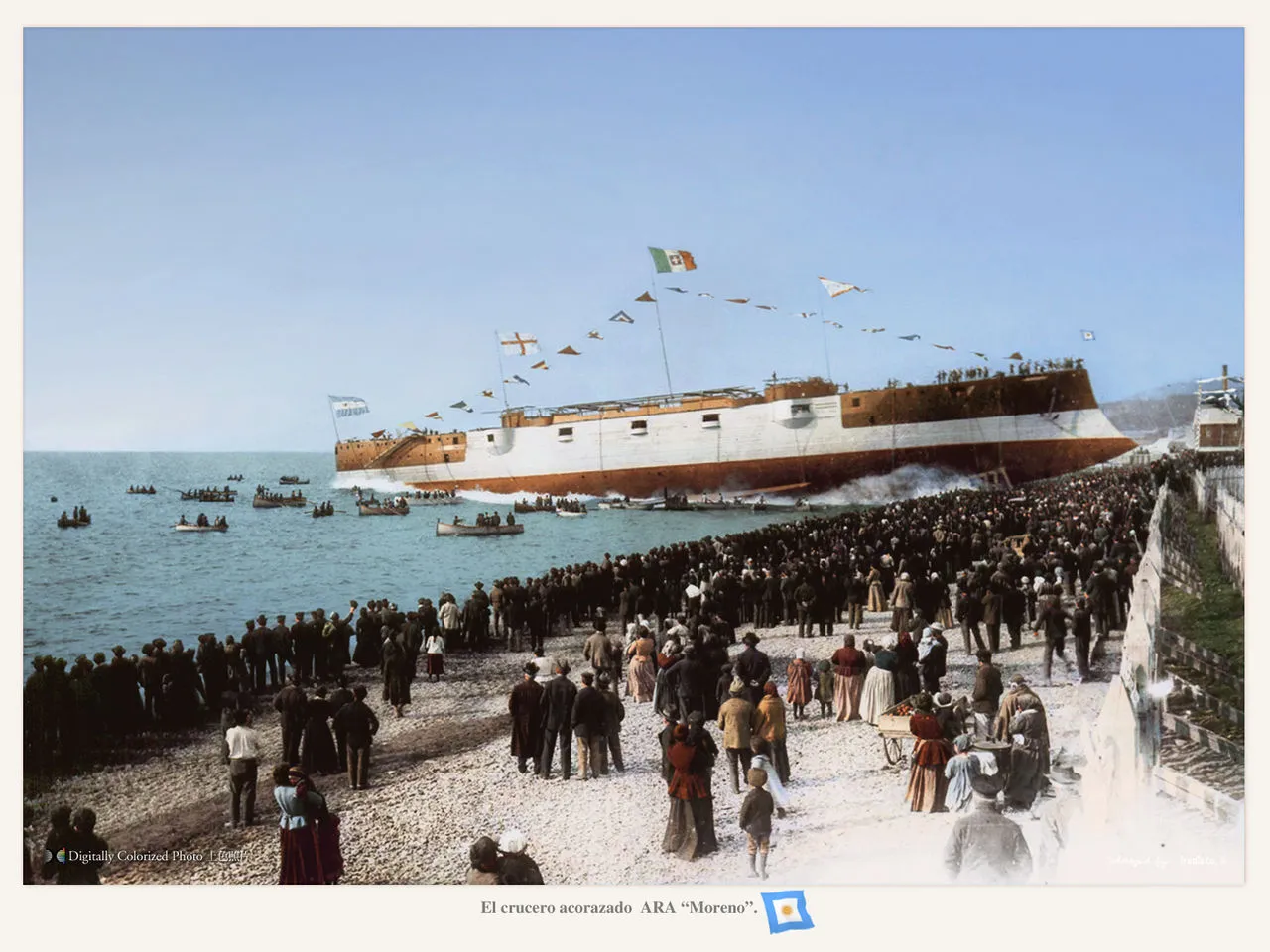
Launch of ARA Moreno (ex-ARA Roca) in February 1903. Note the unpainted parts still in antirust red primer.
It is interesting to note that the Argentinian had plans for two more of the same class, allegedly called Roca and Mitre at first, and then Moreno and Rivadavia (later used for a class of dreadnought when the naval race fired up again, this time against Brazil). They were renamed Kasuga and Nisshin after the order was cancelled. With six armoured cruisers of that nature, added to to all protected cruisers already built, Argentina would have by far surpassed not only Chile, but also Brazil, and even prove a match for the US fleet at the time, still ongoing a rapid rise. It was certainly larger than the local (Cuban) Spanish fleet also if any fight would flare again long after the Pacific war.
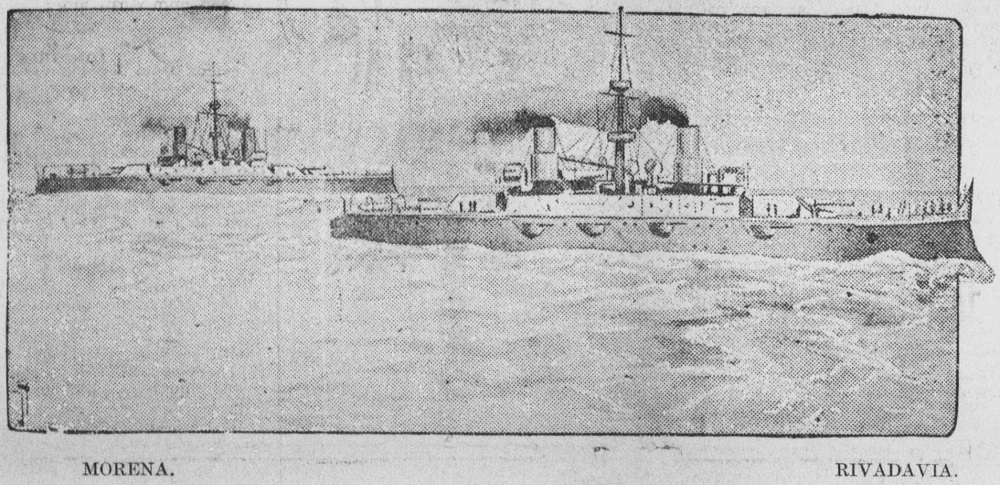
A publication of the time showing an impression of Rivadavia and Moreno at sea.
ARA Mitra (Later Rivadavia) was laid down at Ansaldo, Genoa, Italy on 10.3.1902, launched rapidly on 22.10.1902 and was sold incomplete on 1.1904 to Japan as Kasuga.
ARA Roca (later Moreno) came from the same yard, laid down on 5.1902, launched 9.2.1903 and also sold incomplete the same day to Japan, later renamed Nisshin.
The early named are rather strange and were never resued by the Argentinian Navy;
Anyway, the Garibaldi, San Martin, General Belgrano, Pueyrredon all displaced 6,775 tonnes, whereas Rivadavia as larger and displaced 7,630 tonnes, while Moreno even reached 7,700 tonnes.
Design of the class
Hull and general design
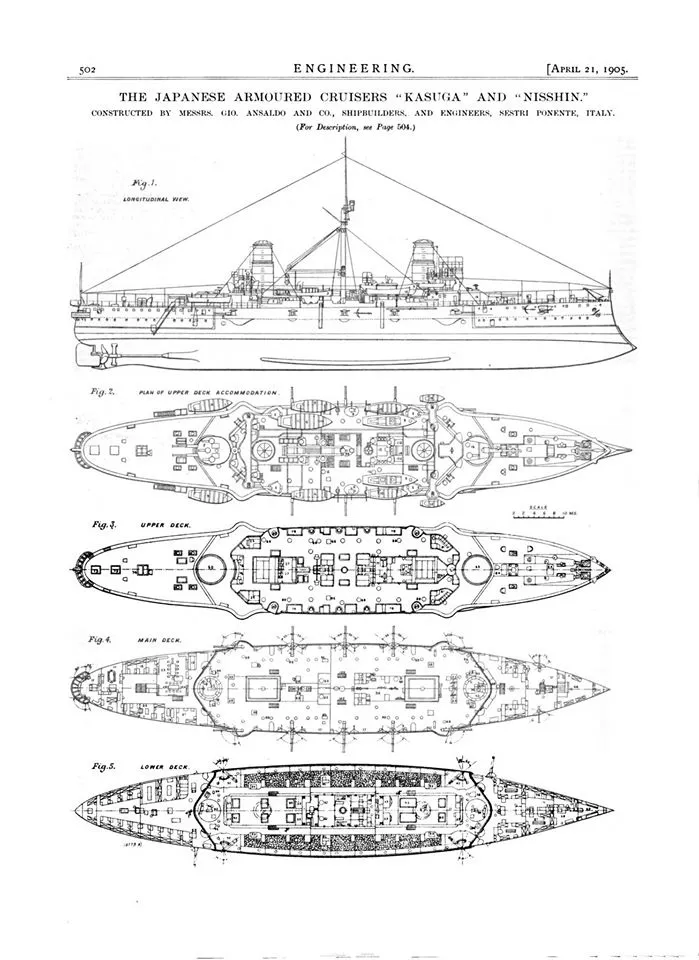
Nisshin-Kasuga, ex Moreno class, cutaway and elevation (“the engineer”). They were beamier and heavier than the first four ships of the class.
The hull was continuous deck steel, with a rounded stern and high sides. The width/length ratio was very high and favored its stability both in navigation and as a shooting platform. The superstructures were almost completely symmetrical, with a stern castle and a forward one on which the command tower rose. In the central section between the two castles there were two funnels with a circular section. The rudder was of the semi-compensated type.
The two first ships of the class were built in Gio. Ansaldo & C. in Genoa-Sestri Ponente, except ARA San Martin and ARA Belgrano which were subcontracted to Orlando in Livorno.
They had roughy the same measurements, but the last five were stretched by six frames amidships (Italian Garibaldi sub-class) and Japanese vessels. The first (Argentinian) group had an overall length of 106.94 meters (350 ft 10 in), beam of 18.2 meters (59 ft 9 in) and a deep draft (ship) of 7.1 meters (23 ft 4 in) while displacing 6,840 metric tons (6,730 long tons) at normal load.The ARA General Belgrano was reported by some sources to have 18.8 meters (61 ft 8 in) beam, for 300–400 metric tons (300–390 long tons) more.
The general architecture, reducing the superstructures to the essential minimum, decreased both the target offered to the enemy and the tonnage.
Armour protection layout
The armor was Harvey-type case-hardened steel, using a US-invented process making an alloy of high hardness. This type of armour however still lacked the necessary elasticity to better absorbe punishment, smehing later improved by Krupp by adding chromium, making them lighter in addition.
The Garibaldis armor was uniform:
Belt: Nickel-plated steel plates 150 mm (6-in) thick, reduced to 80 mm (3.14-in) at the ends.
Central citadel: 130mm (5-in) thick cross members
Armored deck: 38 mm thick (1.5-in) with slight curvature. There was an upper deck 25 mm thick.
Main turrets: 150 mm (6-in) barbettes and shields.
Secondary casemates 152/40 guns: 130 mm (5-in).
Conning Tower: 150 mm (6-in)
Underwater protection consisted only of a double bottom only, with limited compartmentation immediately below the waterline. This was in 1914 woefully unsufficient as one of the Italian ship was sunk by the submarine with just one hit.
ARA Puyrredon differed on some aspetcs: Her belt was the same as her bulkheads 150 mm or 6-in, main gun barbettes were also 150 mm thick as the turrets shields, casemates. The main deck was of 37 mm however, and the secondary deck, below the weather deck was 25 mm thich. Gun shields for the upper battery were of 50 mm and the CT: 150
Powerplant
The machinery space housed two triple expansion reciprocating engines, fed by steam produced by 24 boilers all coal-fired; Both machines and the boilers came from different suppliers. Garibaldi, San Martin, General Belgrano, and the planned Rivadavia and Moreno had likely Ansaldo steam engine (unknown boilers, 8 cylindrical types) but ARA Pueyrredon had 16 Belleville small tubes boilers (twice as much, but smaller).
The machines drove two four-bladed (leaf) bronze propellers on solid casted shafts. During trials, ARA Garibaldi developed 14,713 hp for a top speed of 19.7 knots.
Garibaldi, San Martin, General Belgrano and the planned Rivadavia and Moreno developed on average 13,000 shp, while Puyreddon developed 13,500 shp.
They were all nomonally capable of 20 knots on paper, but that would only be achieved by overheating boilers and push the machinery hard, with light load. In practice sto spare coal they rarely ventured beyond 18 knots.
For endurance, they carried 1,200 tons of coal in normal conditions, but could have carried much more in wartime, filling all void compartments and the double bottom hull.
This enabled a range of 4,800 nm at 10 knots, well enough to venture from Buenos Aires to Ushuaia and back.
Armament
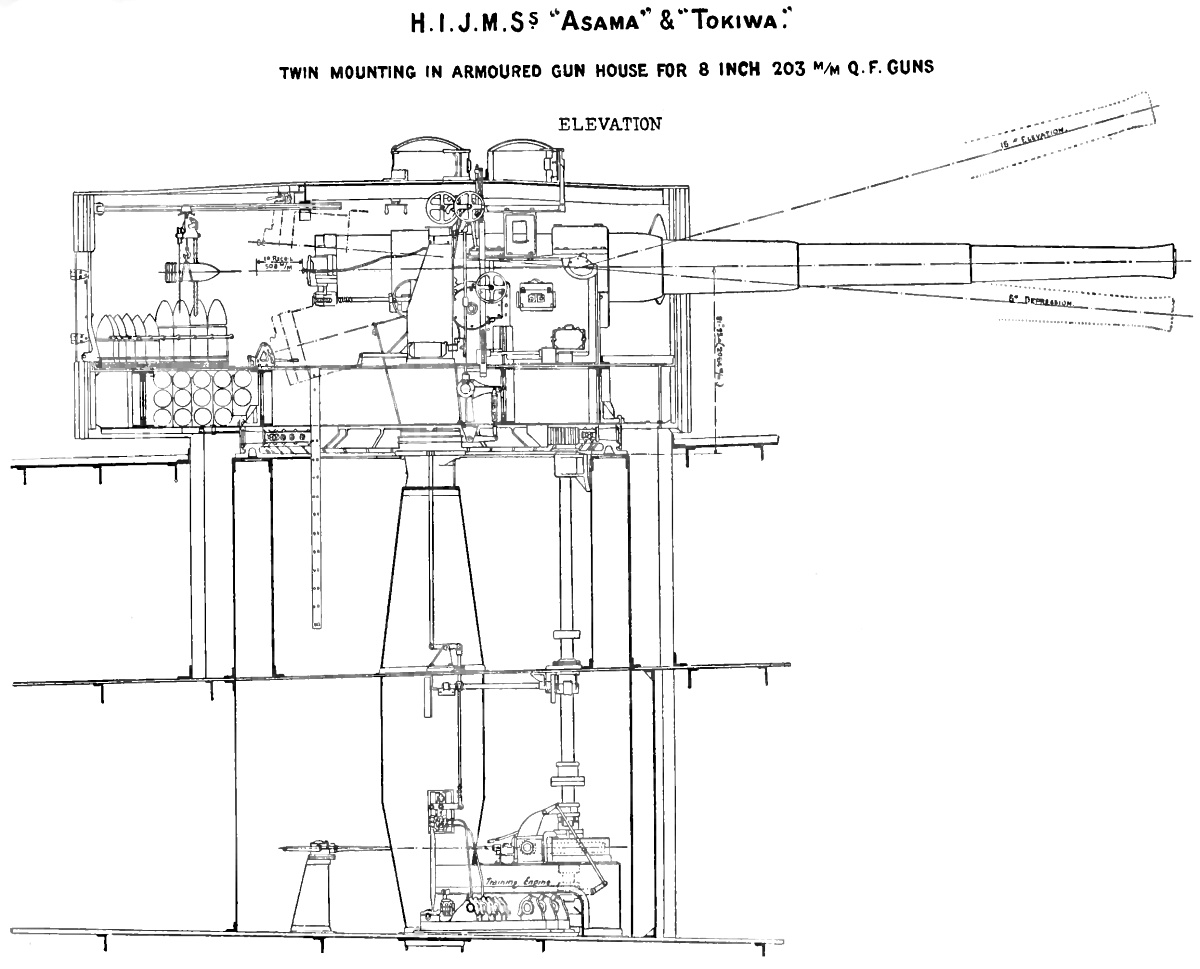
Armstrong 1904 twin turret design, a similar system was installed on ARA San Martin and Rivadavia-Moreno.
The class in general was unusual as the main armament was “a la carte”, alternating between forward single 10-inch Elswick gun or twin 8-in guns. Cristobal Colon (the Spanish one of the serie) was the only one with two 10-inch guns for and aft, but they were rejected for defects shortly before installation and she was sunk at Santiago without. The Argentinian ships had the “usual” configuration of a single 10-in forward and two 8-in aft, which was convenient for a chase, but ARA San Martin differed (see below).
Garibaldi and San Martin had twin turrets with Armstrong guns, ten 152/40 Armstrong Z, sux 120mm/41, ten single 57mm/40, ten 37mm/20 Hotchkiss.
General Belgrano and Pueyrredon instead had two 10-in (254mm/40) Armstrong guns and fourteen 152mm/40 Armstrong, only two 76mm/40 Armstrong N, then ten 57mm/40 and twelve 37mm/20 Hotchkiss
The last two Rivadavia class had a single 254mm/40 forward and two 203mm/45 Armstrong aft, fourteen 152mm/40, ten 76mm/40, six 47mm/40 Hotchkiss
Moreno even differed in having two twin turrets with 203mm/45 Armstrong U types, and the same.
Main
The armament, despite some differences between the various units, they had a certain uniformity. Large caliber artillery consisted of two EOC 10 gun in Pattern R (10″/40 (25.4 cm) EOC Pattern P1), 10-inches or 254mm/40 mm forward (elevation +35º, weighting 30,532 kg).
Only San Martin and Garibaldi had two pairs of EOC 8 guns in Pattern W of 8-inches or 203mm/45 mm (elevation +25°, weighting 19,356 kgs), and it was revised for two single 10-in.
Thus in the end, three carried two 10-in guns, while ARA San Martín had four 8-in guns. Spanish Cristóbal Colón was to have been equipped the same way as the Argentinian Garibaldi class with two 10-in in guns, but due to the rush in which they were commissioned, they were sent as is to Cuba.
The Japanese Kasuga had the same armament as the Garibaldi, but IJN Nisshin armed like San Martín.
The cannons and armor of the Garibaldi class were produced by the Società degli Alti Furnaces, Foundries and Steelworks of Terni.
The 10-in gun was capable of 2,297 fps (700 mps) muzle velocity, at a max range of About 19,700 yards (18,000 m) at 20° at a ROF 1.5 rounds per minute
The 8-in guns were capable 2,600 ft/s (790 m/s), ROF 2 rpm, Range 18 km (11 mi) at 30°
Secondary
It comprised ten single 152 mm (6 in) guns (in other ships that was fourteen, but all Argentinian Garibaldi class had the same ten guns. The were located behind the extended armour over the main belt amidship in a battery deck, in five semi-sponsons positions. These were purely broadside guns, with only the four after and forward ones having the capability for firing forward or aft.
These were capable of a ROF 5-7 rounds per minute, Muzzle velocity of 2,154 feet per second (657 m/s) and effective range at 10,000 yards (9,140 m) at 20° elevation.
The second tier battery comprised six single 120 mm (4.7 in) guns. They had a ROF of 5–6 rounds per minute, muzzle velocity of 1,786 feet per second (544 m/s) and same max range of 10,000 yards (9,100 m) at 20°. So given their performances (minus the weight of the shell) was about the same, the ships could have been using the same 6-in guns everywhere, with 14 or even 16 instead.
The 4.7-in guns were located on the upper deck battery behind un-sponsoned bulwarks.
Tertiary
Ten single 76 mm (3 in) guns located in part in the superstuctures fore and aft (4) and the rest in the hull’s enbrasures (4) fore and aft, the last two on the battery deck.
The 6 single 47 mm (1.9 in) guns located in part in the fighting tops (2 forward, 2 aft) and the remaining two likely on the forward structure.
Torpedo Tubes
Four single 450 mm (17.7 in) torpedo tubes were also installed. They were located in the broadside above water, all fixed, firing the standard whitehead torpedoes.
They were likely of the 1888 pattern (introduced 1894):
-Weight : 845 lb (383 kg)
-Length : 11 ft 8 in (3.56 m)
-Warhead : 118 lb (54 kg) wet gun-cotton
-Performance : 26.5 knots (49.1 km/h; 30.5 mph) for 800 yd (730 m)
-Propulsion : Compressed air
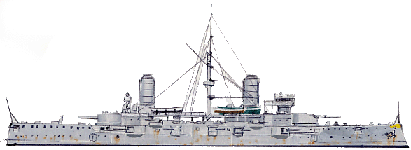
Illustration of the Garibaldi in 1914
⚙ specifications |
|
| Displacement | 6,840 t standard 7,400–7,700 t FL |
| Dimensions | 108.8/111.73 oa x 18.9 x 7.32 m (366 ft 7 in x 62 x 24 ft) |
| Propulsion | 2 shafts VTE, 8–24 Boilers 13,000–13,500 ihp (10,100 kW) |
| Speed | 20 knots (37 km/h; 23 mph) |
| Range | 5,500 nmi (10,200 km; 6,300 mi) at 10 knots (19 km/h; 12 mph) |
| Armament | 1x 254, 10x 152, 6x 120mm, 6x 76 mm, 4x 47mm, 4x 450 mm TTs. |
| Armor | Belt 70-150, CT 150, turrets 190, decks 100-150, barbettes 10-150 mm |
| Crew | 555 total, 578 as flagship |
Career
 ARA Garibaldi (1895)
ARA Garibaldi (1895)
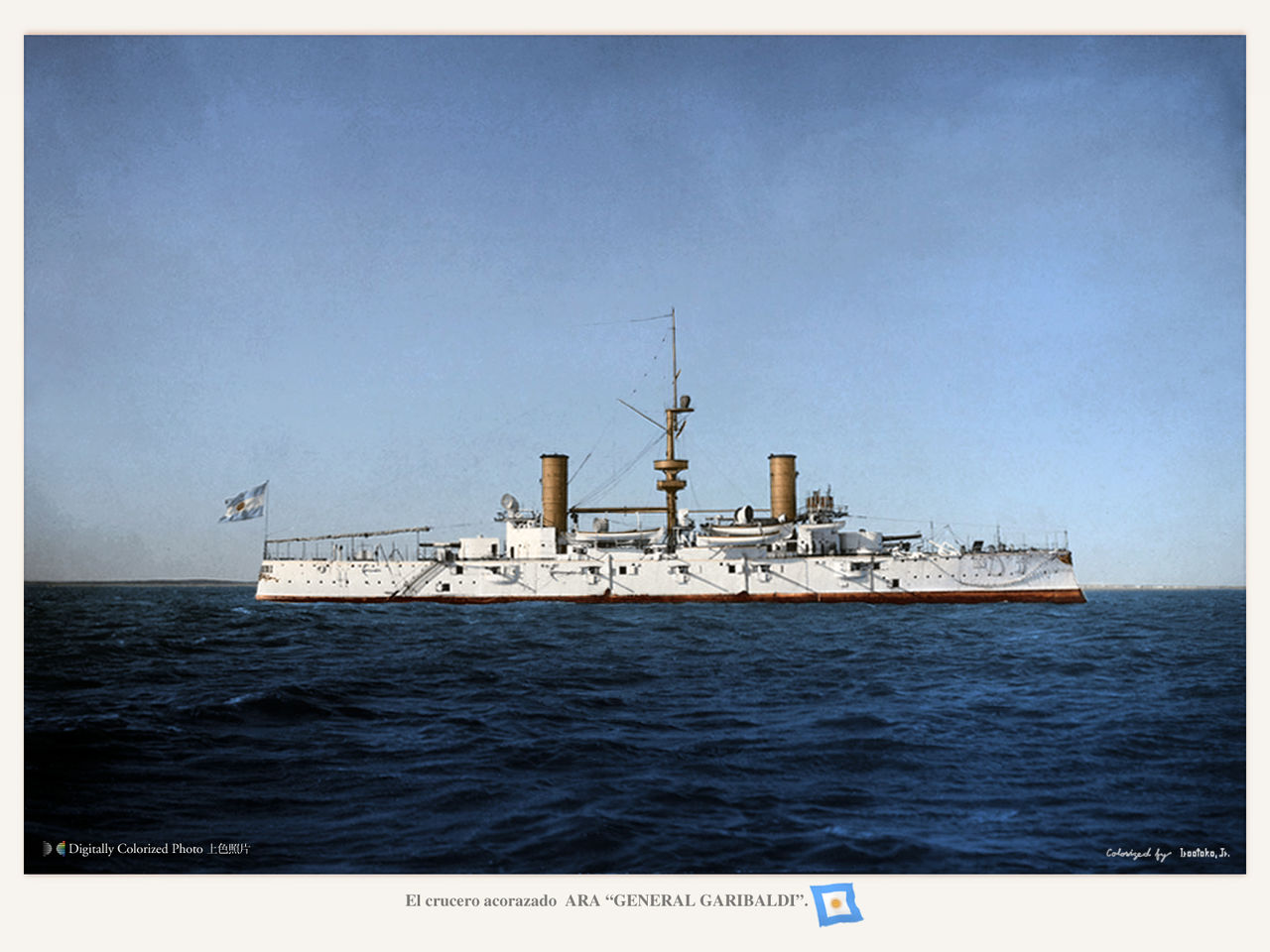
Started as an armored cruiser of that name “Giuseppe Garibaldi” for the Italian Regia Marina, she was sold to Argentina along with her sister ship Varese. The first keep the name and became ARA Garibaldi (The man was also a hero of the Argentian Independence) but the second was named ARA San Martín.
As for her operational history, Garibaldi was commissioned on xxx and left Genoa on October 13, 1896, bound for Argentina. She proceeded through the Mediteranean and across Gibraltar to the Azores to recoal, and then crossed the Atlantic. She arrived in Buenos Aires on December 10, 1896 entering service immediately.
But the expected war never happened.
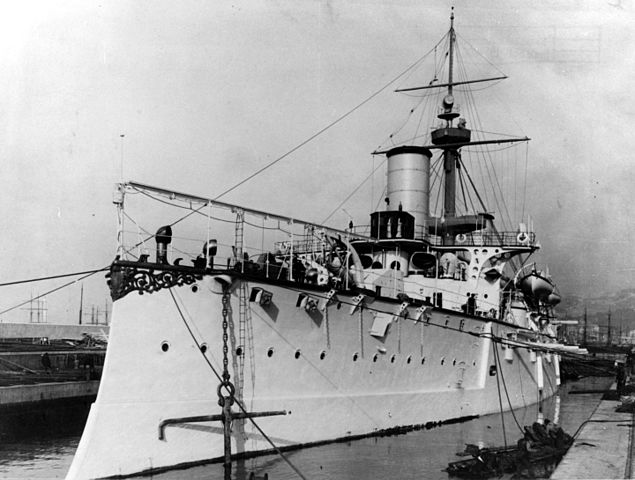
After the crisis with Chile ended, she was “disarmed” on January 21, 1903 as surplus to requirement (financially this had been a catastrophy for Argentina). The word “disarmed” is to be understood put in half commission or reserve. Her armament was untouched. However she was fully recommissioned again in 1908 and assigned to the Artillery School, for officers, signalmen and engineers. What happened was a new naval arms race, this time relaunched by Brazil which ordered a serie of dreadnoughts, Rio de Janeiro (future HMS Agincourt), and the two Minas Gerais class. Argentina, despite having this fleet of cruiser, worried that these dreadnought will completely outmatch its fleet and soon ordered two of its own dreadnought, which were built in the US after a tender. These were given the former cancelled armoured cruiser’s named, Moreno and Rivadavia.
In 1924 in the Río de la Plata, ARA Argentina presented honors, in full regaia, to an Italian Naval Division made up of the new armored cruisers San Marco and San Giorgio, with the Prince of Piemonte aboard, on a state visit to Argentina.
In 1930, she was reclassified as a training ship defintely and by August 31, 1931, decommissioned again, this time completely.
In 1932-1933, she was used as a “parts reserve” to maintain her sister ships still in service. Well cannibalized by March 20, 1934, she was definitively stricken from the Navy list.
On November 5, 1935, she was sold for $150,000 to Julián Nery Huerta, and transferred in turn to Compañía Transatlántica S.A. Argentina Comercial y Marítima. But the latter sold it in turn to a Swedish scrapyard. She still left by her own means and with a commercial crew sent from Sweden, from the port of Río Santiago (Ensenada) to Sweden. She was scrapped there between 1936 and 1937.
 ARA General Belgrano (1896)
ARA General Belgrano (1896)
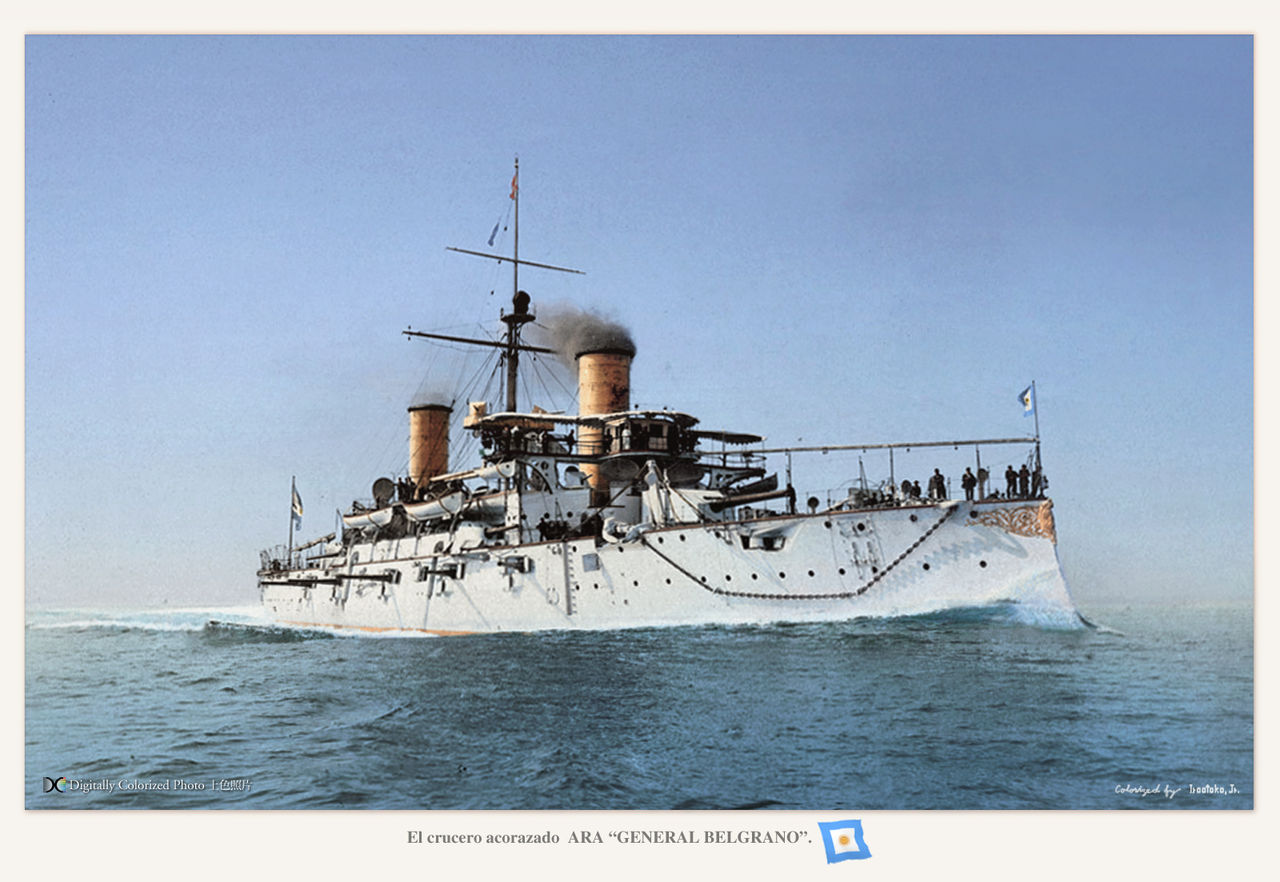
ARA Belgrano, named after the famous general (Manuel José Joaquín del Corazón de Jesús Belgrano y González 1770–1820 which took part in the Independence war and designed the flag) was built at the Cantiere Navale Fratelli Orlando, Livorno. Laid down in 1896, she was launched on 25 July 1897. Purchased in 1898 by the government of Argentina she had extensive sea trials, testing her machinery and artillery until entering service on 8 October 1898, with the flag raised for the first time. She departing the same day from Genoa under command of Captain Emilio Barilari, and arrived by the same route as her sister at Mar del Plata on November 6 1898.
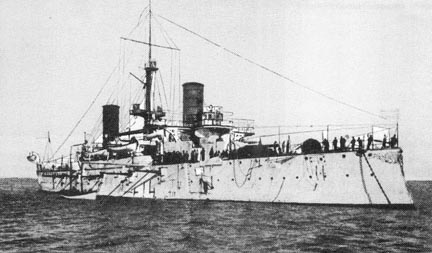
However the expected conflict with Chile never erupted and on 20 January 1899, she carried the President of Argentina Julio Argentino Roca and the President of Chile Federico Errazuriz Echaurren to sign the peace treaty. Belgrano visited Santa Cruz, Rio Gallegos, Puerto Harberton and Ushuaia until reaching on February 15, 1899 Punta Arenas. This was in this place that the two presidents signed the peace treaty.
Without purpose her days were numbered. It is even poissible she could have been sold back to Italy, but the latter moved on since. Another possibility was Japan. This never materlialized either. In 1902, she was “disarmed” (put in reduced commission). She was fitted with a telegraph set in 1907 and after examination and reequipment, recommissioned in full with the fleet in 1908 (as part of the new naval arms race with Brazil). In 1912 she was the first equipped with a wireless radio transmitter.
In 1927 modernization started at Puerto Belgrano. However before the process ended she left for Europe and visiting Genoa from 7 to 16 October. There, the crew attended the unveiling of a monument dedicated to General Belgrano. Later, she visited Spain and was back to Genoa to complete her modernization and overhaul. This included her boilers converison to fuel oil. This also included a new mast and changes in artillery: She saw the removal of six 57mm/40, all ger 37mm/20 Hotchkiss and instead two 76mm/40 (3-in) 12pdr 12cwt QF Mk I/II/V were installed.
Between 1926-1930 while in Odero, Sestri Ponente, General Belgrano had this boilers change, swapping for eight Yarrow oil-firing (1000,t of oil, 13,000 shp, 17kts, 5,600 nm at 10 kts). All her 152mm/40 (6-in) were removed and four 76mm/40 added as well as two 57mm/40 Hotchkiss. Instead she gained eight modern 152mm/40 EOC Z guns in shielded deck mounts. She carried them until the end of her career.
At the end of this modernization she departed Odero on 25 October 1929 and arrived home at Buenos Aires on 24 November. In 1933, she was reclassified as coast guard ship. By December she was sent to Mar de Plata to be used as a depot ship for submarines. On 8 May 1947 after nearly 50 years of service she was stricken. Towed to Buenos Aires, she was broken up in the Matanza River shipyards.
 ARA Pueyrredón (1898)
ARA Pueyrredón (1898)
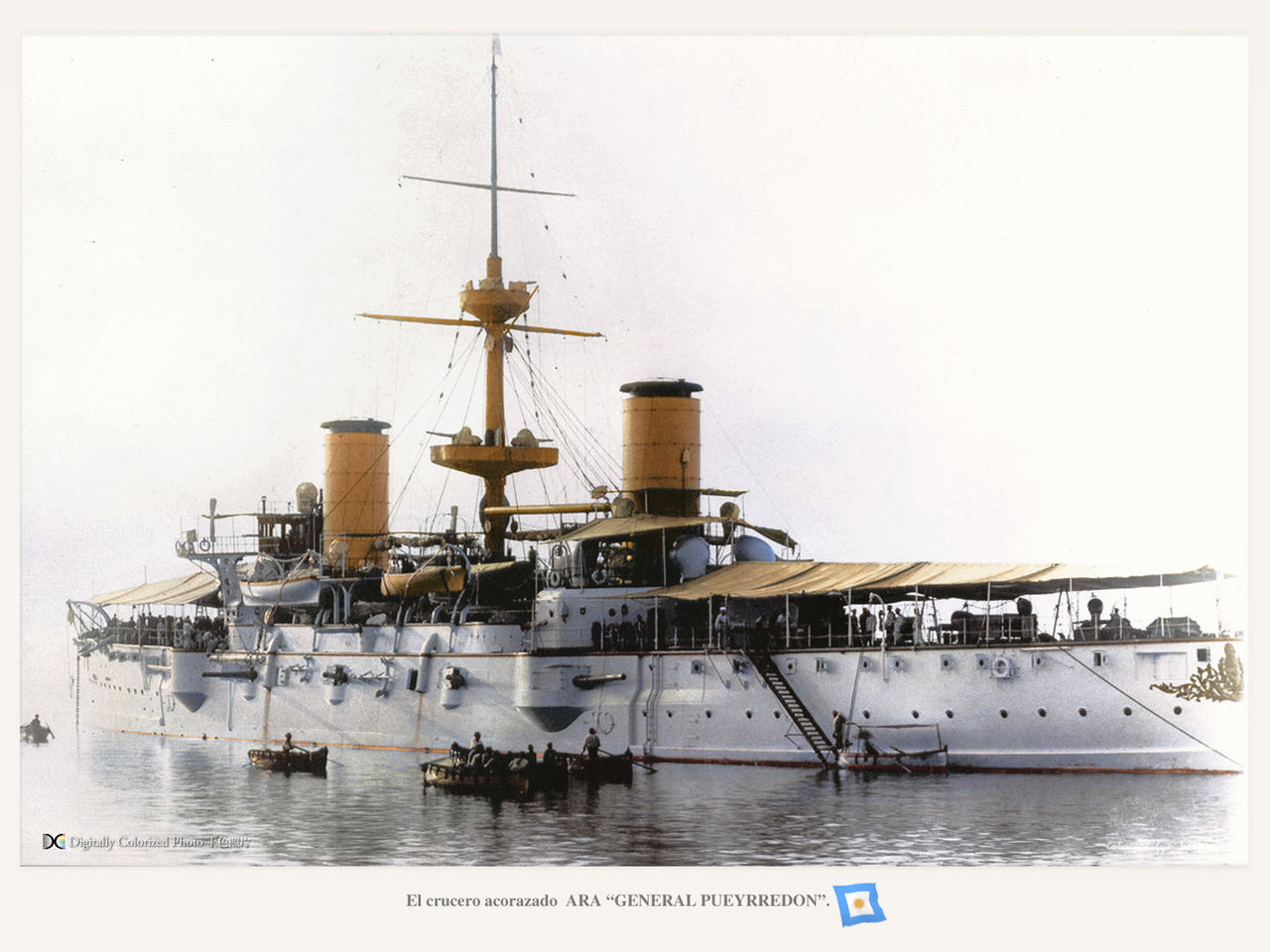
Pueyrredón differed from other ships as having eight Scotch marine boilers. She was also armed with the two 10-inch (254 mm) guns. As for her records, they are not known in great detail. She was commissioned in August 1898 and sailed to Argentina soon after. Like the others she had no purpose after peace was signed and to spare budget, reduced in half-commission and reserve, likely recommissioned fully in 1908. From 1912 she liley took training roles.
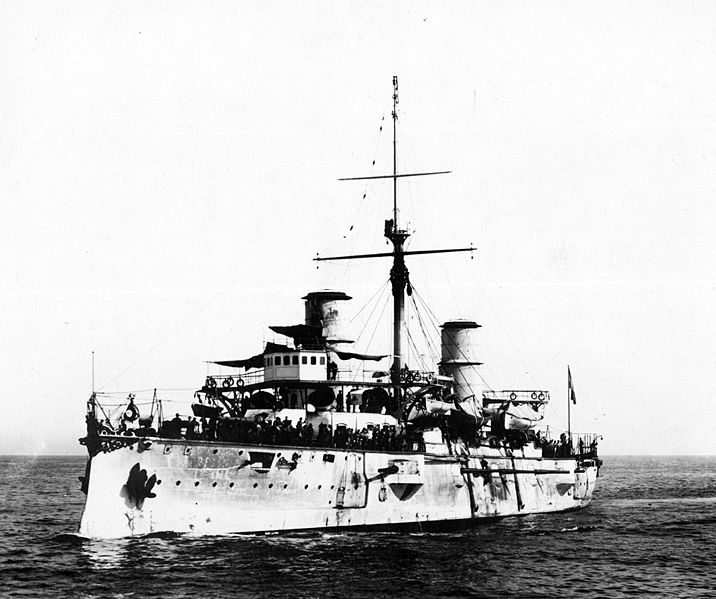
She was modernized in 1926-1937 at Puerto Belgrano Naval Yard: Her boilers were replaced by eight Yarrow oil-firing ones, same as fitted on her sister Belgrano. As for armament, all fourteen 152mm/40 guns were removed as well as two 76mm/40 and two Hotchkiss 57mm/40 guns and in exchange, she earned eight 152mm/40 EOC Z types in shielded deck mounts, so she ended basically as her sister Belgrano and probably reclassified as a coast guard ship in the 1930s as she could only be capable of 17 knots. In 1941 she became a permament training ship. In WW2 she was campuflaged as shown on photos. She was eventually stricken in August 1954, the last armoured cruiser still in service anywhere in the world. She was stricken on 2 August 1954 and by January, 1955 sold for BU, to a Japanese company, towed off in Japan.
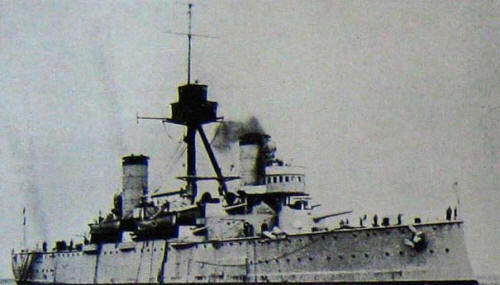
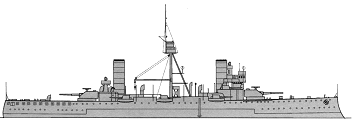
Appearance of the Puyerredon 1941-1954.
 ARA San Martín (1896)
ARA San Martín (1896)
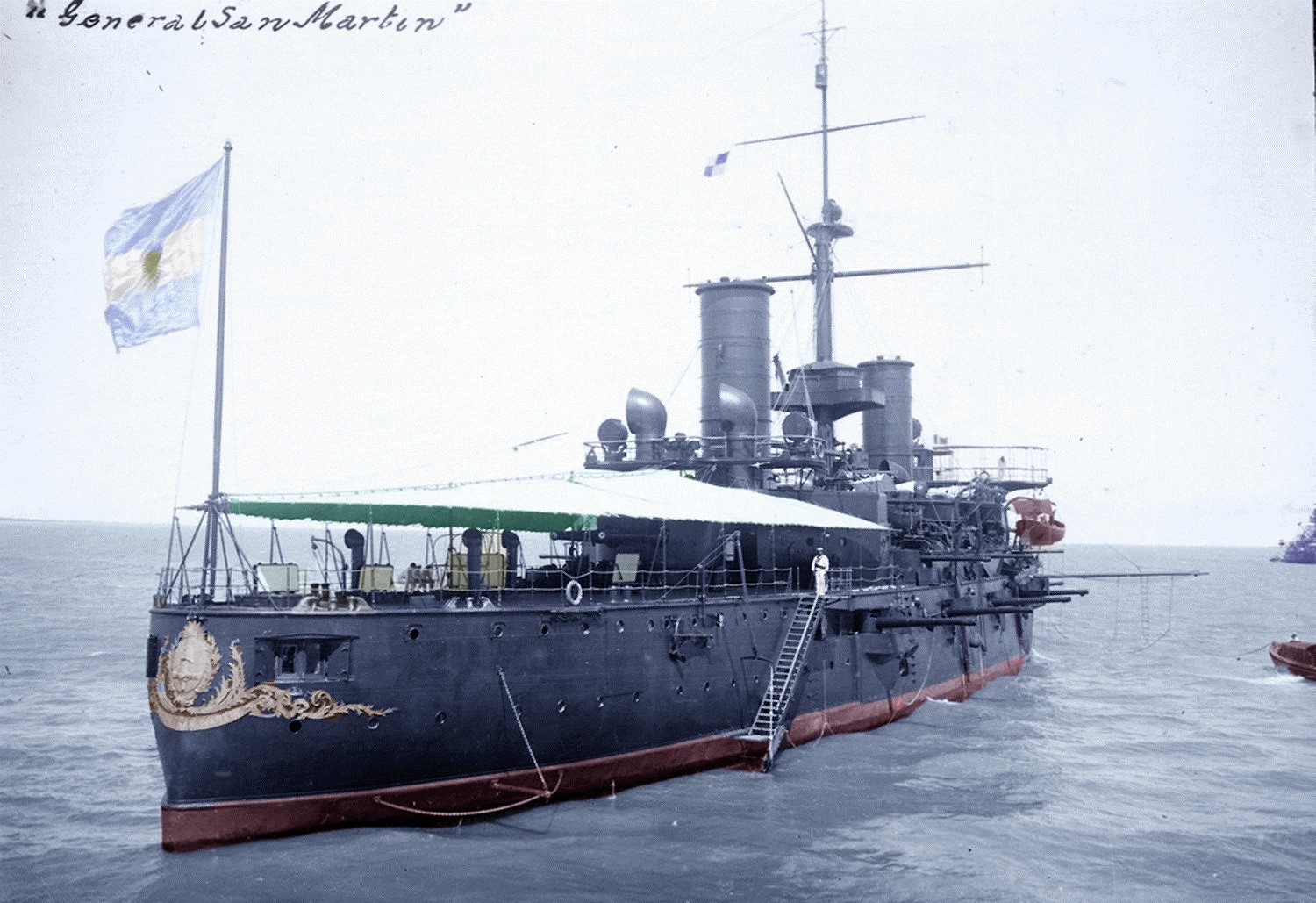
ARA San Martin was launched on May 25, 1895. She entered service on April 25, 1898 and started her career under command of Captain Manuel José García Mansilla before departing for Argentina. She performed her sea trials, followed by acceptance artillery trials off La Spezia.
On April 25, 1898 she was accepted by the Argentinian navy and set sail for home. She stopped at Gibraltar and Bahía in Brazil before making it to Punta Piedras, on June 13, joining the main battle Squadron. She took part in the great naval maneuvers of 1902 as the flagship, first Sea Division.
She later carried the commission in charge of signing the territorial agreements between Chile and Argentina to Santiago de Chile. After this she virtually had no purpose left. It is unsure of she was partly decommissioned and placed in reserve like her sisters though.
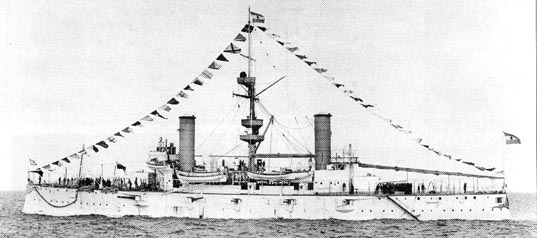
She indeed stayed as flagship of the Fleet until 1911.
In 1919 she was sent to crush a worker’s insurrection in the south of the country.
In 1926 it was modernized at Puerto Belgrano Naval Base: Her coal-fired boilers were replaced by oil-firing ones, her artillery and superstructures were modified.
Four 57mm/40 and all her 37mm/20 Hotchkiss guns were removed and instead two single 76mm/40 (3-in) 12pdr 12cwt QF Mk I/II/V guns were installed.
She was decommissioned by decree 7300 of December 8, 1935, placed in mothball, pending a sell to a shipbraker, which was done by 1947, scrapped at the Riachuelo workshops.
Links/Sources
Books
Fraccaroli, Aldo (1970). Italian Warships of World War I. London: Ian Allan.
John Gardiner’s Conways all the world’s fighting ships 1860-1906, Italian section
Gardiner, Robert & Gray, Randal, eds. (1985). Conway’s All the World’s Fighting Ships: 1906–1921.
“Professional Notes–Italy”. Proceedings of the United States Naval Institute. NIP
Silverstone, Paul H. (1984). Directory of the World’s Capital Ships. New York: Hippocrene Books
Sondhaus, Lawrence (2001). Naval Warfare, 1815–1914. London: Routledge.
United States Office of Naval Intelligence, United States Navy (July 1901). “Steam Trials–Italy”. Government Printing Office
Links
https://it.wikipedia.org/wiki/Classe_Giuseppe_Garibaldi
https://laststandonzombieisland.com/tag/garibaldi-class-cruiser/
http://www.navweaps.com/Weapons/WNJAP_10-40_EOC.php

 Latest Facebook Entry -
Latest Facebook Entry -  X(Tweeter) Naval Encyclopedia's deck archive
X(Tweeter) Naval Encyclopedia's deck archive Instagram (@navalencyc)
Instagram (@navalencyc)





 French Navy
French Navy Royal Navy
Royal Navy Russian Navy
Russian Navy Armada Espanola
Armada Espanola Austrian Navy
Austrian Navy K.u.K. Kriegsmarine
K.u.K. Kriegsmarine Dansk Marine
Dansk Marine Nautiko Hellenon
Nautiko Hellenon Koninklije Marine 1870
Koninklije Marine 1870 Marinha do Brasil
Marinha do Brasil Osmanlı Donanması
Osmanlı Donanması Marina Do Peru
Marina Do Peru Marinha do Portugal
Marinha do Portugal Regia Marina 1870
Regia Marina 1870 Nihhon Kaigun 1870
Nihhon Kaigun 1870 Preußische Marine 1870
Preußische Marine 1870 Russkiy Flot 1870
Russkiy Flot 1870 Svenska marinen
Svenska marinen Søværnet
Søværnet Union Navy
Union Navy Confederate Navy
Confederate Navy Armada de Argentina
Armada de Argentina Imperial Chinese Navy
Imperial Chinese Navy Marinha do Portugal
Marinha do Portugal Mexico
Mexico Kaiserliche Marine
Kaiserliche Marine 1898 US Navy
1898 US Navy Sovietskiy Flot
Sovietskiy Flot Royal Canadian Navy
Royal Canadian Navy Royal Australian Navy
Royal Australian Navy RNZN Fleet
RNZN Fleet Chinese Navy 1937
Chinese Navy 1937 Kriegsmarine
Kriegsmarine Chilean Navy
Chilean Navy Danish Navy
Danish Navy Finnish Navy
Finnish Navy Hellenic Navy
Hellenic Navy Polish Navy
Polish Navy Romanian Navy
Romanian Navy Turkish Navy
Turkish Navy Royal Yugoslav Navy
Royal Yugoslav Navy Royal Thai Navy
Royal Thai Navy Minor Navies
Minor Navies Albania
Albania Austria
Austria Belgium
Belgium Columbia
Columbia Costa Rica
Costa Rica Cuba
Cuba Czechoslovakia
Czechoslovakia Dominican Republic
Dominican Republic Haiti
Haiti Hungary
Hungary Honduras
Honduras Estonia
Estonia Iceland
Iceland Eire
Eire Equador
Equador Iran
Iran Iraq
Iraq Latvia
Latvia Liberia
Liberia Lithuania
Lithuania Mandchukuo
Mandchukuo Morocco
Morocco Nicaragua
Nicaragua Persia
Persia San Salvador
San Salvador Sarawak
Sarawak Uruguay
Uruguay Venezuela
Venezuela Zanzibar
Zanzibar Warsaw Pact Navies
Warsaw Pact Navies Bulgaria
Bulgaria Hungary
Hungary

 Bundesmarine
Bundesmarine Dutch Navy
Dutch Navy Hellenic Navy
Hellenic Navy Marina Militare
Marina Militare Yugoslav Navy
Yugoslav Navy Chinese Navy
Chinese Navy Indian Navy
Indian Navy Indonesian Navy
Indonesian Navy JMSDF
JMSDF North Korean Navy
North Korean Navy Pakistani Navy
Pakistani Navy Philippines Navy
Philippines Navy ROKN
ROKN Rep. of Singapore Navy
Rep. of Singapore Navy Taiwanese Navy
Taiwanese Navy IDF Navy
IDF Navy Saudi Navy
Saudi Navy Royal New Zealand Navy
Royal New Zealand Navy Egyptian Navy
Egyptian Navy South African Navy
South African Navy






























 Ukrainian Navy
Ukrainian Navy dbodesign
dbodesign